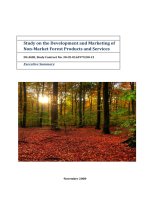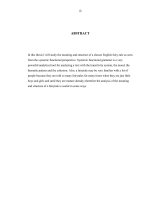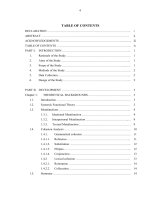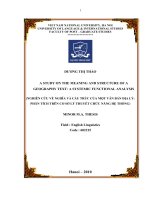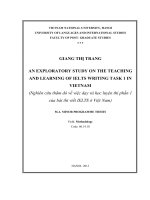Dissertation summary: Study on the synthesis and application of polymers containing suitable funtional groups for seperation some light rare earth elements
Bạn đang xem bản rút gọn của tài liệu. Xem và tải ngay bản đầy đủ của tài liệu tại đây (1.69 MB, 27 trang )
MINISTRY OF EDUCATION
AND TRAINING
VIETNAM ACADEMY OF
SCIENCE AND TECHNOLOGY
GRADUATE UNIVERSITY OF SCIENCE AND TECHNOLOGY
-----------------------------
HOANG THI PHUONG
STUDY ON THE SYNTHESIS AND APPLICATION OF
POLYMER CONTAINING SUITABLE FUNTIONAL GROUPS
FOR SEPERATION SOME LIGHT RARE EARTH ELEMENTS
NGƯỜI H Scientific Fied: Organic Chemistry
Classification Code: 9.44.01.14
S. Nguyễn
Văn Khôi
DISSERTATION SUMMARY
HA NOI - 2018
The dissertation was completed at:
Institute of Chemistry
Vietnam Academy of Science and Technology
Scientific Supervisors:
1. Prof. Dr. Nguyen Van Khoi
Institute of Chemistry – Vietnam Academy of Science and
Technology
2. Dr. Trinh Duc Cong
Institute of Chemistry – Vietnam Academy of Science and
Technology
1st Reviewer : ………………………………………………………….
…………………………………………………………
2nd Reviewer: ………………………………………………………….
…………………………………………………………
3rd Reviewer: ………………………………………………………….
…………………………………………………………
The dissertation will be defended at Graduate University of Science
and Technology, Vietnam Academy of Science and Technology, 18
Hoang Quoc Viet, Cau Giay District, Ha Noi City.
At ……hour…….date……….month…….2018
The dissertation can be found in National Library of Vietnam and the
library of Graduate University of Science and Technology, Vietnam
Academy of Science and Technology.
INTRODUCTION
1. Background
Rare earths are the special minerals, which are considered by many
countries in the world and classified on material grade that can’t be
replaced because they have many special properties. Rare earth elements
play a very important role in development of high-tech fields, such as:
electricity, electronics, optics, lasers, superconductors materials and
luminescent materials.
Thus, the title of dissertation was proposed: “Study on the synthesis
and application of polymers containing suitable funtional groups for
seperation some light rare earth elements”, to study on synthesize,
characterization and application of polymers for sorption some light rare
earth elements.
2. Objectives of the dissertation
Successfully synthesis polymers containing suitable funtional groups
to seperate the light rare earth element (La, Nd, Pr, and Ce); evaluted the
efficiency of polymers on seperating light rare earth element; evaluated the
ability of polymers on separating each of the rare earth metal ions on the
ion exchange column.
3. Main contents of dissertation
- Synthesis polymers containing suitable funtional group for the
separation of the rare earth elements:
+ Synthesis poly(hydroxamic acid) from acrylamide (PHA-PAM).
+ Synthesis poly(hydroxamic acid) from acrylamide and vinyl
sulfonate (PHA-VSA).
- Studied on adsorption, desorption process; and evaluted the ability
of two polymers on adsorpting some light rare earth metal ions (La3+, Ce4+,
Pr3+ and Nd4+).
- Studied and evaluted the capable of PHA resin on seperating some
light rare earth elements (La3+, Ce4+, Pr3+ and Nd4+).
4. Structure of the thesis
The dissertation has 138 pages, including the literature review,
experiment, results and discussions, conclusions, pubblication, with 45
1
images, 45 tables and 114 references.
B. CONTENTS OF DISSERTATION
CHAPTER I. LITERATURE REVIEW
An overview of domestic and foreign publications on rare earths,
methods for seperate light rare earth metal ions; overview researchs on
synthesis and application of polymers containing suitable funtional groups
to separate rare earth metal ions. From there, the research orientation of the
dissertation were proposed.
CHAPTER II. EXPERIMENTAL
2.1. Materials and equipments
2.1.1. Materials
Acrylamide (AM), Sodium vinyl sulfonate (VSA), Ammonium
persulfate; N, N’ - methylene bisacrylamide hydroxylamine hydrochloride
(HA); Span 80, Paraffin oil, diesel oil, Dowex HCR-s resin, Amberlite IR
120 resin, standard solution: La(NO3)3, Ce(NO3)3, Pr(NO3)3, Nd(NO3)3;
solution which contain light rare earth metal ions with content: La 3+ 36.76
wt%, Ce4+ 47.79 wt%, Pr3+ 4.41 wt%, Nd3+ 11.03 wt% was seperated and
provided by Institute for Technology of Radioactive and Rare Elements,
Vietnam.
Chemicals for analysis: distilled water, NaOH, NaHCO3,HCl, H2SO4,
CH3OH,C2H5OH, C20H14O4, HNO3, C6H14, CHCl3, H2C2O4, CH3COOH,
CH3COONa were used without purification.
2.1.2. Equipments
Equipments for suspension polymerization with three-liter of
volume, ion exchange column, vacum dry cabinet, thermostatic tank,
analytical balance, magnetic stirrer instrument, thermometer, flasks, the
condenser system, triangular flasks, pipette,...IR spectrometer, Perkin
Elmmer emission spectrometer, thermogravimetric analyze instrument,
FESEM scanning electron microscope, pH measuring equipment.
2.2. Methods
2.2.1. Synthesis poly(hydroxamic acid) based on acrylamide
Processes of synthesize cross-linking polyacrylamide (PAM gel) and
2
synthesize poly(hydroxamic acid) (PHA) based on cross-linking
polyacrylamide were presented in figure 2.4-2.6.
- Diesel
- Span 80
Continuous Phase
V1 (ml)
Invesstigated the
factors:
- AM Concentration
- Temperature and time
- Content of MBA
- Content of ABS
- Content of Span 80
- The stirrier speed
- Monomer phase/oil
phase ratio
- Acrylamide: C%
- MBA
- APS
Dispersed Phase
V2 (ml)
Reaction flask
with 3 liters of
volume
Filtered
Feed speed:
10ml/min
Washed by nhexane
Cross-linking PAM
Dried at 60oC
long in 5 hours
Cross-linking PAM
(granulate form with
same size)
Figure 2.4. Synthesis of PAM-gel
PAM-gel
(10 g PAM + 50 g H2O)
Stirred: 100 rpm
Time: 30 minutes
Reaction flask
with 3 liters of volume
Add NH2OH.HCl solution with
concentration: 1-3.5 M, pH:10-14
Reation mixture: temperature
T (oC), time t (min)
Filtered
Invesigated the
factors
- Temperature and time
of reation
- pH of medium
-Concentration
of
NH2OH.HCl
Washed by water to
pH=7
Dried: 60oC, in 5 hours
Polyhydroxamic acid
(granulate form had similar
size and light yellow of colour)
Figure 2.6. Sythesis of poly(hydroxamic axit) based on modification of
3
PAM-gel
2.2.2. Synthesis poly(hydroxamic acid) from acrylamide and sodium
vinyl sulfonate
2.2.2.1. Co-polymerization process of acrylamide and sodium vinyl sulfonate
To investigated the coefficient of copolymerization process,
controlled the conversion of reactions ≤ 10% (by reacting at very low
concentration condition, experimented several times to conversion reached
≤ 10%). Synthesis 5 samples of copolymer with difference of VSA/AM
molar ratio: 10/90, 30/70, 50/50, 60/40, 70/30 and 90/10; other conditions
of reaction didn’t change.
2.2.2.2. Synthesis
polymerization
cross-linking
P(AM-co-VSA)
by
suspension
Process of synthesize cross-linking P(AM-co-VSA) was similar the
suspension polymerization of AM; monomer were AM and VSA with
VSA/AM weight ratio was 60/40.
2.2.2.3. Modification of P(AM-co-VSA) to poly(hydroxamic acid)
modified processes of copolymer of AM and VSA (P[AM-co-VSA]gel) were carried out similarly the modification of PAM-gel to PHA-PAM.
2.2.3. Adsorption and de-adsorption the rare earth matal ions by PHA-PAM
and PHA-VSA
Adsorption: take 0.15 g PHA-PAM (or PHA-VSA) to reation flask
containing 50 ml each of ion solution: La3+, Ce4+, Pr3+ and Nd3+ with
research concentration, strirred at room temperature. After reation time,
measured the remaining concentration of each metal ion in solution using
ICP-OES method.
* Investigated the factors that effect on adsorption process: pH, time,
initiator concentration of metal ions.
* Adsorption isotherms: From the results obtained when investigated
of factors on the adsorption process, Langmuir isotherm models was
constructed.
2.2.4. Studied on desorption and repeated use of poly(hydroxamic acid) resin
Conducted six adsorption - desorption cycles using 0.15g of
adsorbent material. After each cycle, measured the percentage of metal
adsorbed, the percentage of metal desorbed and the loss weight of
4
absorbent.
2.2.5. Absorbed the light rare earth ions on column by PHA-PAM
Process of seperation light rare earth metal ions was showed in figure
2.8
Light rare earth metal ions composition:
La3+, Nd3+, Pd3+ và Ce4+
- Concentration: 500mg/l
-pH=6; acetate buffer: 0.5 M
Quantitative pump
- : 130 ml/minute
Ion exchange column
- Dcolumn : 20mm
- Lcolumn : 800mm
- Lresin : 500mm
Adsorbed in 180 minutes
Washed with HCl 0.5M
- Flow: 3-7 ml/minute
- Vr/Vn: 3/1 – 18/1
Nd3+
rich fraction
Pd3+
rich fraction
Ce4+
rich fraction
Adsorbed and desorped each fraction on ion exchange column
Eluted by
HCl: 0,6M
Eluted by
HCl: 0,1M
Eluted by
HCl: 0,2M
Eluted by
HCl: 0,4M
Figure 2.8. Process of seperation light rare earth metal ions from rare earth
metal solution by PHA resin
CHAPTER III. RESULTS AND DISCUSSION
3.1. Study on synthesis of poly(hydroxamic acid) based on acrylamide
3.1.1. Study on synthesis of cross-linked polyacrylamide (PAM-gel)
5
In this study, the continuous phase used was diesel oil. Factors
influencing product properties were investigated such as temperature (7095oC) and time (60-240 min), monomer concentration (15-35%), APS
concentration (0, 5-1.75), crosslinker concentration (7-11%), monomer /
oil phase ratio (1 / 5-1 / 3), surfactant span 80 concentration (0.1-0, 35)
and stirring speed (200-400 rpm). The results are presented in tables 3.13.6)
Table 3.1. Effect of temperature and reaction time on characterization of
PAM-gel
Temp. (oC)
70
80
90
95
Gel1
(%)
91,4
95
94,8
98,6
99,5
-
Time
(min)
180
240
60
90
60
60
D2TB
(m)
~ 180
187
230
-
Product characteristics
Granular, block
Granular, block
Granular, block
Discrete round granular
Discrete round granular
block
Gel contents (%)
Reaction efficiency reached the maximum value at 90oC, 60 minutes.
Thus, the condition of 90oC and 60 minutes was chosen as the reaction
condition for the next study.
35%
30%
25%
20%
15%
0
20 Time40
(min) 60
80
100
Figure 3.1. Effect of monomer concentration and reaction time on gel
content of PAM-gel
When the monomer concentration increases from 15% to 30%, the
gel content increases and the reaction time decreases. However, when
monomer concentration is high (35% sample), the polymerization process
is very fast, difficult to control the reaction process. Therefore, 30%
monomer was chose for optimal reaction temperature and time.
1
Gel content of products
Average granular diameter of the product
2
6
Table 3.2. Effect of initiator concentration on gel content and swelling
capacity of PAM-gel
KPS concentration, %
0,5
0,75
1,0
1,25
1,5
1,75
Gel content, %
93,2 96,8 99,5 98,4
98,0
97,3
Swelling capacity, g/g
3,2
3,9
4,7
4,2
3,8
3,6
Results showed that the optimum KPS concentration for PAM-gel
synthesis was 1.0%.
Table 3.3. Effect of crosslinker concentration on swelling capacity and
gel content of PAM-gel
7
8
9
10
11
MBA concentration (%)
6,2
5,8
5,5
4,7
4,1
Swelling capacity (g/g)
98
98
98,4
99,5
99,5
Gel content (%)
Increasing of crosslinker concentration from 7 to 11%, reduce the
swelling capacity from 6,2 to 4,1 g/g. Chosen MBA content is 10% for
next study.
Table 3.4. Effect of ratio of monomer/oil phase on particle
characteristics
Ratio of
Average diameter of
Characteristics and
monomer/oil
granular` DTB(m)
separability of granular
phase
1/5
225
Round granules, evenly
1/4
230
Round granules, evenly
1/3
partially blocked
At a monomer/oil phase ratio of 1/4, the granulation process is better,
distributing the particle size more uniformly than the rest.
Table 3.5. Effect of suspension stabilizer on particle characteristics
Span 80
Gel content
Average
content (%)
,%
diameter of
Characteristics and
granular
separability of particles
DTB(m)
0,10
99,2
Unround granules, block
0,20
99,6
Unround granules, block
0,30
99,5
230
Round granules, evenly
0,35
98,5
Granular and partially
emulsified
7
Results in table 3.5 showed that, with 0,3% span 80, product are
round granules, evenly.
Table 3.6. Effect of stirring speed on particle size distribution
Stirring speed
Particle size distribution (%)
(rpm)
< 100(m)
100÷500(m)
>500(m)
200
7
55
38
300
4
92
4
400
38
57
5
With 300 rpm, the product is more uniform, with a particle size of
100-500m is 92% (Average diameter of granular is about 230 m).
Thus, the optimal conditions for PAM-gel synthesis are: Reaction
temperature 90oC for 60 minutes, 30% of monomer, 10% of crosslinker (in
monomer), 1% of initiator, 0,3% of Span 80 at 300 rpm and ¼ of the phase
ratio monomer/oil.
+ Characteristic of PHA-gel: Particle size distribution with D ~230
µm, swelling capacity: 4.7 g/g and gel content of 99.5%.
3.1.2. Sythesis of poly(hydroxamic axit) based on modification of PAM-gel
To study the modification of PAM-gel into poly(hydroxamic acid)
(PHA-PAM) by hydroxylamine, PAM-gel are 100-500 µm in size,
humidity <58%. Study on factors affacting the modification of acrylamide
group to hydroxamic acid group such as temperature (25-40oC), time (0-24
hours), pH (pH=10-14) and concentration of NH2OH.HCl (1.0-3.5M). The
results are shown in figure 3.6 and tables 3.9-3.10.
-CONHOH (mmol/g)
12
10
8
6
4
2
0
25 0C
30 0C
40 0C
0
6
12
Time (hrs)
18
24
Figure 3.6. Effect of reaction temperature and time on funtional group
content
When the temperature increases form 250C to 300C, -CONHOH
content increases from 9,8 to 11,4 mmol/g after 24h.
Table 3.9. Effect of pH on funtional group content
pH
-CONH2 (mmol/g) - COOH (mmol/g) - CONHOH (mmol/g)
8
10
11
12
13
14
12,93
12,57
8,54
3,94
2,30
1,25
1,50
1,75
1,70
1,68
1,14
1,25
5,03
9,68
11,34
Table 3.9 shows that the pH in the 10-11 range, the modification is
very slow (low -CONHOH content). In the pH range of 12-14, the content
of -CONHOH group increased gradually and reached the maximum value
at pH=14.
Table 3.10. Effect of NH2OH.HCl concentration on funtional group
content
NH2OH.HCl
-CONH2
-COOH
-CONHOH
Concentration
(mmol/g)
(mmol/g)
(mmol/g)
(M)
1,0
5,38
1,45
8,49
2,0
4,39
1,57
9,36
3,0
3,09
1,61
10,62
3,3
2,30
1,68
11,34
3,5
2,26
1,72
11,34
Table 3.10 shows that at the concentration of NH2OH.HCl 3.3M, the
content of -CONHON group is the highest.
➢ Physical and chemical characteristics of PHA-PAM
Characteristic properties of PHA-PAM are evaluated by FTIR
spectroscopy, thermo gravimetric analysis (TGA), scanning electron
microscopy (SEM). The results are shown in Tables 3.11-3.12 and Figures
3.9-3.10.
Table 3.1. FTIR characteristic of groups in PHA-PAM
Wavenumber (cm-1)
Bending
Funtional group
3436-3190
2928
2857
1668
1009
N-H, -OH
C-H
C=N
C=O
N-O
Amine (-NH2), -COOH
Alkyl (-CH2)
-CONHOH (enol form)
Cacbonyl (-C=O)
-CONHOH
9
Hình 3.9. TGA curves of PHA-PAM
Hình 3.10. SEM image of
PHA-PAM
Table 3.12. The PHA-PAM thermal analysis data
Stage
1
2
3
Range of temp. oC
Tp-220
220-340
340-450
TMax, oC
186
307
385
Loss weight, %
9,33
17,81
35,15
The optimal conditions for the modification of PAM-gel into PHAPAM are 3.3 M hydroxylamine hydrochloride, at 30oC for 24 hours at pH
14. PHA-PAM contains -CONH2 group content of 2.3 mmol/g, -COOH
group 1.68 mmol/g and -CONHOH group 11.34 mmol/g.
3.2. Synthesis of poly(hydroxamic axit) based on acrylamide and
sodium vinyl sulfonate
3.2.1. Copolymerization of acrylamide và sodium vinyl sulfonate
3.2.1.1. Effect of reaction temperature, time and initiator concentration
The temperatures were studied 65, 70, 75oC, time range of 60-24
minutes, initiator concentration: 0,5; 0,75; 1; 1,2%. The results are shown
in figure 3.11-3.12.
10
100
Conversion (%)
100
80
Conversion (%)
80
60
60
65 oC
70 oC
75 oC
40
20
0,50%
0,75%
1,00%
1,20%
40
20
0
0
0
60
120
180
Time (min)
0
240
60
120
180
Time (min)
240
Figure 3.10. Effect of reaction
Figure 3.11. Effect of initiator
temperature and time on
cocentration on conversion
conversion
The react condition was chosen: temp. 70oC, time 180 minutes and
1% initiator.
3.2.1.2. Determine the reactivity ratios of monomers
Determination of intermediate coefficients and in the KelenTudos equation. The results are shown in Table 3.14.
Table 3.14. Determination of coefficients và
Mẫu
M1
M2
M3
M4
M5
M6
[M 1 ]
=x
[M 2 ]
0,111
0,429
1,000
1,500
2,333
9,000
d M 1
x2
=y F=
y
d M 2
0,175
0,630
1,070
1,580
2,380
7,310
0,07
0,29
0,93
1,42
2,29
11,08
G=
x( y − 1)
= Fmin Fmax
y
-0,52
-0,25
0,07
0,55
1,35
7,77
0,88
=
F
G
=
+F
+F
0,07
0,25
0,51
0,97
0,72
0,93
-0,55
-0,21
0,04
0,40
0,43
0,65
From equation = 1,3883 – 0,6197 with α = 0,88 extrapolation to
= 0 so rVSA = 0,547, = 1 so rAM = 0,768.
3.2.2. Copolymerization of acrylamide and sodium vinyl sulfonate by
suspension polymerization
In this study, continuous phase is diezen oil. Factors influencing
product properties were investigated such as temperature (70-90oC) and
time (60-240 min), monomer concentration (4,63-40%), APS
concentration (0, 5-1.75), crosslinker concentration (7-11%), monomer /
oil phase ratio (1 /5-1/3), surfactant span 80 concentration (0.1-0, 35) and
stirring speed (200-400 rpm). The results are presented in tables 3.15-3.20)
11
Table 3.15. Effect of reaction time and temperature
Temp.
(oC)
700C
800C
900C
Time
(phút)
180
240
60
Gel3
(%)
93
100
-
D4TB
(m)
175
-
90
100
230
60
100
232
Characteristics of product
Granular, block
Granular, unblock
Granular, adhesive
Even round granules,
separately
Even round granules,
separately
Table 3.16. Effect of crossliker concentration on gel content and
swelling capacity of copolymer P[AM-co-VSA]
MBA concentration (%)
7
8
9
10
11
Gel content, (%)
99
99
99
99
99
Swelling capacity (g/g)
12,6
9,5
7,2
5,4
4,3
Table 3.17. Effect of monomer concentration on product characteristics
Monomer
Gel5
D6TB
concentration
Time
Product characteristics
(%)
(m)
(%)
4,63
100
180
85
Small granules
10
100
150
115
Small granules
20
100
90
175
granularly
Even round granules,
30
100
60
232
separately
40
100
50
325
Uneven granules, separately
Table 3.18. Effect of monomer/oil ratio
Ratio of
Average granular
Product characteristics
monomer/oil
diameter DTB(m)
1/5
215
Round granules, good
dispersion
1/4
232
Round granules, good
dispersion
1/3
Partially blocked
3
4
Gel content of products
Average granular diameter of the products
5
6
Gel content of products
Average granular diameter of the products
12
Table 3.19. Effects of surfactant span 80 concentration
Span 80 (%)
Average granular
Product characteristics
diameter DTB(m)
0,10
Unround granules
0,20
Unround granules
0,30
232
Evenly, round granules
0,35
Granular and partially suspenion
Table 3.20. Effect of stirring speed
Mix speed
Gel content (%) Average granular diameter DTB(m)
(rpm)
<100
100-500
>500
200
>99
8
50
42
300
>99
5
90
5
400
>99
45
50
5
The result was a optimum synthetic condition: reaction temperature
o
90 C for 60 minutes, 30% of monomer, 8% of crosslinker (in monomer),
0,3% of Span 80 at 300 rpm.
3.2.3. Sythesis of poly(hydroxamic axit) based on modification of P[AMco-VSA]
In this study, Study on factors affacting the modification of P(AMco-VSA) to poly(hydroxamic acid) (PHA-VSA) were investered such as
temperature (25-50oC), time (0-24 hours), pH (pH=10-14) and
concentration of NH2OH.HCl (1.0-3.5M). The results are shown in figure
3.18 and tables 3.22-3.23.
-CONHOH (mmol/g)
8
6
25 oC
4
30 oC
2
40 oC
50 oC
0
0
6
12
18
24
Time (min.)
Figure 3.18. Effect of reaction temperature and time on funtional group
content
13
Bảng 3.22. Effect of pH on
funtional group content (mmol/g)
pH
10
11
12
13
14
-SO3Na
mmol/g
3,05
3,05
3,05
3,05
3,05
Bảng 3.23. Effect of NH2OH.HCl
concentration on funtional group content
- CONHOH
mmol/g
1,2
1,53
4,24
7,15
8,135
NH2OH.HCl(M
)
1,0
2,0
3,0
3,3
3,5
-SO3Na
mmol/g
3,05
3,05
3,05
3,05
- CONHOH
mmol/g
3,74
4,98
8,135
8,01
3,05
7,89
Optimal condition for the modification of P(AM-co-VSA) to (PHAVSA): temperature 30oC for 18 hours, pH =14 with NH2OH.HCl 3.0M.
➢ Product characteristics
The results of IR spectral analysis, thermal TGA, surface
morphology of PHA-PAM are shown in Table 3.24 and Figures 3.18-3.19.
Table 3.24. Wavenumber of funtional group of P(AM-co-VSA)
Wavenumber (cm-1)
Bonds
Groups
3425
N-H
Primary (-NH2)
2933
C=N
-CONHOH (enol form)
1666
C=O
-CONH2 and -CONHOH
1182
S-O
-SO31037
S=O
-SO3-
Figure 3.18. TGA thermal analysis diagram of PHA-VSA
14
Figure 3.1. SEM image of PHA-VSA
Summany of item 3.2:
- The optimal condition for the copolymerization of acrylamide and
sodium vinyl sulfonate: reaction temperature 90oC for 60 minutes, 30% of
monomer, 8% of crosslinker (in monomer), 1% of initiator, 0,3% of Span
80 at 300 rpm and ¼ of the phase ratio monomer/oil.
+The optimal condition for the modification of P[AM-co-VSA] into
PHA-VSA: reaction temperature 30oC for 18 hours, concentration of
NH2OH.HCl 3.0M, pH14 at 100 rpm.
+ Characteristic of PHA-PAM: Particle size distribution with D
~232 µm, swelling capacity: 9.67 g/g, -CONHOH content: 8.315 mmol/g, SO3Na content: 3,05 mmol/g.
3.3. Adsorption and desorption of rare earth ions by PHA-PAM and PHAVSA
3.3.1. Adsorption of rare earth ions by PHA-PAM and PHA-VSA
In this study, the important factor that influence the adsorption
processes include pH, time and initial metal concentration. The results are
shown in figures 3.20-3.25.
120
120
90
90
Q (mg/g)
150
Q (mg/g)
150
La(III)
Ce(IV)
Pr(III)
Nd(III)
60
30
3
4
5
pH
6
7
30
0
0
2
La(III)
Ce(IV)
Pr(III)
Nd(III)
60
2
8
3
4
5
6
7
8
pH
Figure 3.20. Effect of pH on the
adsorption process of PHA-PAM
Figure 3.21. Effect of pH on the
adsorption process of PHA-VSA
15
150
120
120
90
La(III)
Ce(IV)
Pr(III)
Nd(III)
60
Q (mg/g)
Q (mg/g)
150
30
90
60
30
0
0
0
60
120
Time (min)
180
0
240
Figure 3.22. Effect of time on the
adsorption process of PHA-PAM
150
150
120
120
90
90
La(III)
Ce(IV)
Pr(III)
Nd(III)
60
30
120 180
Time (min)
240
300
La(III)
Ce(IV)
Pr(III)
Nd(III)
60
30
0
0
0
60
Figure 3.23. Effect of time on the
adsorption process of PHA-VSA
Q (mg/g)
Q (mg/g)
La(III)
Ce(IV)
Pr(III)
Nd(III)
0
100 200 300 400 500 600
Initial metal concentration (mg/l)
Figure 3.24. Effect of initial metal
concentration on the adsorption
process of PHA-PAM
100 200 300 400 500 600
Initial metal concentration (mg/l)
Figure 3.25. Effect of initial metal
concentration on the adsorption
process of PHA-VSA
The results shown that, optimal condition for adsorption process:
pH=6, initial metal concentration is 500 mg/L metal ion, in 180 minutes.
✓ Isothermal absorption
Isothermal absorption Langmuir equations were built for La3+, Ce4+,
Pr3+ và Nd3+, are shown in figure 3.29.
Table 3.25. Parameters of adsorption Langmuir process
La3+
Pr3+
Ce4+
R2(Langmuir)
0,97735 0,97746 0,9686
RL
0,112
0,175 0,133
PHAqmax (mg/g)
234,19 209,64 196,08
PAM
qe
143,5 131,42 129,33
b bond energy constant
0,0159 0,0094 0,013
2
0,9557 0,9908 0,9901
PHA- R (Langmuir)
VSA RL
0,123
0,126 0,204
16
Nd3+
0,9075
0,190
212,77
136,67
0,0085
0,9390
0,235
qmax (mg/g)
192,31 178,57 153,85 178,57
qe
129,6 125,54 115,33 121,07
b bond energy constant
0,0142 0,0078 0,0138 0,0065
The values of RL in range of 0,112-0,235, less than 1, the Langmuir
isothermal model is suitable for adsorption La3+, Ce4+, Pr3+ và Nd3+ on
PHA-PAM, PHA-VSA.
Besider, the maximum adsorption capacity of PHA-PAM was higher
than PHA-VSA. Therefore, PHA-PAM is chosen for next study.
3.3.2. Desorption rare earth metal ions by PHA-PAM
150
150
120
Ce4+ content (mg/g)
La3+ content (mg/g)
3.3.2.1. Effect of eluted solution
In this study, the desorption of rare earth metal ions (La3+, Ce4+, Pr3+
and Nd3+) form the PHA-PAM resin were investigated with 0.5M HCl,
0.5M acitic acid and 0.5M oxalic acid aqueous solutions. The results of
desorption efficiency for rare earth metal ions in three eluted solution are
shown in Figures 3.30-3.33.
HCl 0.5M
Axetic 0.5M
Oxalic o.5M
90
60
30
0
0
60
120
180
240
300
HCl 0.5M
Axetic 0.5M
Oxalic 0.5M
120
90
60
30
0
0
360
60
120 180 240 300 360
Time (min)
Time (min)
Figure 3.31. Effect of eluted solution
on desorption of ion Ce4+
150
150
HCl 0.5M
Axetic 0.5M
Oxalic 0.5M
120
90
60
30
Nd3+ content (mg/g)
Pr3+ content (mg/g)
Figure 3.30. Effect of eluted
solution on desorption of ion La3+
HCl 0.5M
Axetic 0.5M
Oxalic 0.5M
120
90
60
30
0
0
0
60
0
120 180 240 300 360
Time (time)
Figure 3.32. Effect of eluted
solution on desorption of ion Pr3+
60
120 180 240
Time (min)
300
360
Figure 3.33. Effect of eluted solution
on desorption of ion Nd Nd3+
According to the results mentioned above, HCl solution was an
17
effective and suitable desorption agent for recovering rare earth metal ions
from PHA-PAM resin.
3.3.2.2. Effect of elution HCl concentration
Studying HCl concentration in range of 0,1-0,8M. The results are
shown in figure 3.34.
1000
La(III)
800
Pr(III)
Ce(IV)
600
Kd
Nd(III)
400
200
0
0
0.1
0.2
0.3
0.4
0.5
0.6
0.7
0.8
HCl content (M)
Figure 3.34. Effect of elution concentration on separability of ions from
PHA-PAM
-Ion Nd3+ : good separability at ~ 0,1M HCl.
- Ion Pr3+ : good separability at ~ 0,2M HCl.
- Ion Ce4+: good separability at ~ 0,4M HCl.
- Ion La3+ : good separability at ~ 0,6M HCl.
3.3.3. Desorption and repeated use
The plastic used in this study was PHA-PAM. After desorption, PHAPAM resin was regenerated by washing with distilled water to neutral pH, dried
in vacuum at 60 ° C to constant volume and continued for six adsroption –
desorption cycles each metal ion. The results showed that the adsorption capacity
of PHA-PAM decreased slightly after six adsorption – desorption cycles, but
adsorption capacity remained high. Adsorption capacity of PHA-PAM after six
adsorption – desorption cycles with La3 +, Ce4 +, Pr3 + and Nd3 + ions were
95.2, 95.7, 95.6, and 94.2 respectively.
3.3.4. Comparision of Dowex, Amberlit and PHA-PAM adsorbents
The process of adsorption of rare earth metal ions on Dowex,
Amberlite and PHA-PAM resins and the desorption are carried out under
the same conditions. The results are shown in Table 3.30.
18
Bảng 3. 2. Adsorption capicity and desorption percentage of Dowex,
Amberlit and PHA-PAM with La3+, Ce3+, Pr3+, Nd3+
Resin
Adsorption capacity,
desorption percentage
Dowex
PHAPAM
Nhựa
Amberlit
Rare earths metal ions
Adsorption capacity, q (mg/g)
Desorption percentage (%)
La3+
122,8
76,14
Ce3+
108,7
73,38
Adsorption capacity, q (mg/g)
143,5
129,33
Desorption percentage (%)
Adsorption capacity, q (mg/g)
Desorption percentage (%)
95,2
120,2
75,87
95,7
109,8
75,04
Pr3+
110,4
69,42
Nd3+
111,6
71,44
136,6
131,42
7
95,6
94,2
111,4 108,7
65,68 70,15
The results show that adsorption capacity and desorption percentage
of Dowex and Amberlite are lower than PHA-PAM.
Summany of item 3.3
- The optimal conditions for the adsorption of rare earth metal ions
to PHA-PAM and PHA-VSA including: initial metal concentration of 500
mg/l for 180 minutes at pH 6. Under all conditions, the adsorption
capacity of PHA-PAM for rare metal ions (La3+, Ce3+, Pr3+, Nd3+) were
higher than PHA-VSA.
- Elution conditions: the adsorbed Nd3+, Pr3+, Ce4+ and La3+ on
PHA-PAM could be desorbed in 0.1M, 0.2M, 0.4M and 0.6M HCl,
respectively.
- Comparison of rare earth metal ions adsorption of Dowex,
Amberlite and PHA-PAM resins, the results show that the adsorption
capacity and desorption percentage of PHA-PAM resin are higher than
the other two resins.
3.4. Separating individual ions in lighter rare earth solution by PHAPAM on ion exchange column
In this study, the lighter rare earth solution was seperated from rare
earth Dong Pao (seperated and supplied by Institute for Technology of
Radioactive and Rare Elements). The components of lighter rare earth
solution shown in table 3.29.
Table 3.29. Chemical components of lighter rare earth solution
Item
Ion components
Content
(mg/l)
%
1
La(III)
185,4
36,76
2
Ce(IV)
238,9
47,79
19
3
4
Pr(III)
Nd(III)
Đất hiếm nhẹ (g/l)
23,9
51,8
500mg/l
4,41
11,03
3.4.1. Studying of desorption process
3.4.1.1. Effect of volumn and rate of eluted solution
The elute solution is 0.5M HCl with Vr/Vn ratios from 3:1 to 18:1.
The results are shown in table 3.30.
Table 3.30. Effect of volumn and rate of eluted solution
Total amount of rare earth ions is eluted (%)
Vr/Vn
(ml)
v1 = 3 ml/min.
v2 = 5ml/min.
v3 = 7ml/min.
3:1
34,84
59,94
45,24
6:1
71,85
85,21
78,38
9:1
90,02
91,05
90,87
12:1
91,52
92,91
92,85
15:1
93,54
98,20
97,19
18:1
97,04
98,34
98,22
The results show that in the Vr/Vn ratios and flow rates, only Vr/Vn
= 15:1 and and flow rate of 5 ml/min for the elution efficiency is the best.
3.4.2. Seperated process for individual La(III), Ce(IV), Pr(III) and Nd(III)
ions from the respective rich segment
3.4.2.1. Seperated process of La3+ ion from La-rich segment
100
La (%)
90 83.3
Ce (%)
80
Pr (%)
70
60
Nd (%)
50
40
30
12.15
20
10
0
92.8
20.68
23.99
Ion concentration (%)
Ion concentration (%)
Seperated process of La3+ from La-rich segment are shown in figure
3.36-3.37.
Segment
Hình 3.36. The result of secondary
adsorption-desorption from primary
La-rich segment
100 92.8
90
80
70
60
50
40
30
20
10
0
96.63
La (%)
Ce (%)
Pr (%)
Nd (%)
27.14
31.28
32.97
Segment
Hình 3.37. The result of tertiary
adsorption-desorption from secondary
La-rich segment
20
La3+ ion content reaches 96,63% in 1721-2400 segment.
3.4.3.2. Seperated process of Ce4+ion from Ce-rich segment
Seperated process of Ce4+ion from Ce-rich segment are shown in
figure 3.38-3.39.
90
80
70
60
100
90.56
La (%)
78.03 Ce (%)
Pr (%)
Nd (%)
50
40
26.18
23.47
30
16.51
20
10
Ion concentration(%)
Ion concentration(%)
100
0
90
80
70
95.94
90.56 La (%)
Ce (%)
Pr (%)
Nd (%)
60
50
40
32.08
29.63
30
22.68
20
10
0
Segment
Segment
Hình 3.38. The result of secondary
adsorption-desorption from primary
Ce-rich segment
Hình 3.39. The result of tertiary
adsorption-desorption from secondary
Ce-rich segment
Ce4+ ion content reaches 95,94% in 1041-1720 segment.
100
90
80
70
60
50
40
30
20
10
0
82.56
68.27
32.89
La (%)
Ce (%)
Pr (%)
Nd (%)
27.94
18.49
Element contetn(%)
Element content(%)
3.4.3.3. Pr3+ seperated process from Pr-rich segment
Seperated process of Pr3+ from Pr-rich segment are shown in figure
3.40-3.42.
Segment
Figure 3.40. The result of secondary
adsorption-desorption from primary
Pr-rich segment
100
90
80
70
60
50
40
30
20
10
0
La (%)
Ce (%)
Pr (%)
Nd (%)
91.87
82.56
36.57
31.68
23.25
Segment
Figure 3.41. The result of tertiary
adsorption-desorption from secondary
Pr-rich segment
21
La (%)
Element content(%)
120
100
Ce (%)
95.87
91.87
Pr (%)
Nd (%)
80
60
40.25
37.72
40
32.94
20
0
Segment
Figure 3.42. The result of quaternary adsorption-desorption from tertiary
Pr-rich segment
Pr3+ ion content reaches 95,87% in 481-1040 segment.
3.4.3.4. Nd3+ seperated process from Nd-rich segment
90
80
70
60
50
40
30
20
10
0
84.99
La (%)
Ce (%)
Pr (%)
Nd (%)
76.64
42.98
35.66
25.92
Segment
100
90
80
70
60
50
40
30
20
10
0
91.52
La (%)
Ce (%)
Pr (%)
Nd (%)
84.99
Ion concentration (%)
Ion concentration (%)
Seperated process of Nd3+ from Nd-rich segment are shown in figure
3.43-3.45.
46.89
36.84
30.69
Segment
Hình 3.43. The result of secondary
adsorption-desorption from primary
Nd-rich segment
Hình 3.44. The result of tertiary
adsorption-desorption from secondary
Nd-rich segment
22
100
91.52
95.42
La
(%)
Element content (%)
90
Ce
(%)
80
70
60
46.89
50
40
32.45
30.09
30
20
10
0
Ban đầu
40-480
481-1040
1041-1720
1721-2400
Segment
Figure 3.45. The result of quaternary adsorption-desorption from tertiary
Nd-rich segment
Nd3+ ion content reaches 95,42% in 40-480 segment.
Summany of item 3.4: Rare earth metal ions (La3+, Ce4+, Pr3+ và Nd3+)
were seperated sucessfully on ion exchanged column with PHA-PAM
resin. The adsorption and desorption by HCl with diferent concentration
were carried out through 4 segments. Recovery efficiency is greater than
95%, purity of element: La-96,63 %, Ce-95,99 %, Pr-95,87 % and Nd95,42 %.
CONCLUSION
1. Poly(hydroxamic acide) based on acrylamide was synthesized
sucessfully through 2 stages:
- Polyacrylamide was synthesized by suspension polymerization
method. The product are round even granules, diameter ~230 µm, gel
content 99,5 % and swelling capacity 4,7 g/g.
- Polyacrylamide was modified to poly(hydroxamic acid) by
hydroxylamine hydrocloride at pH=14, temp. 30 oC in 24 h, 3.3M
NH2OH.HCl. PHA obtained resin is round even granular form, average
diameter ~230 µm, -CONHOH 11.34 mmol/g, -CONH2 2.73 mmol/g, COOH 1.68 mmol/g, swelling capacity 5.23 g/g.
2. Poly(hydroxamic acid) based on acrylamide và sodium
vinylsulfonate (PHA-VSA) was synthesized sucessfully through 2 stages:
- Copolymerization of AM and VSA by reverse suspension
polymerization in oil. Obtained copolymer is round even granular form,
23


